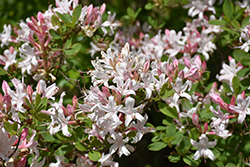Height: 3 feet
Spread: 3 feet
Sunlight:
![]()
![]()
Hardiness Zone: 5b
Other Names: Dwarf Azalea
Description:
A delightlfully fragrant, semi-dwarf variety producing funnel shaped white and pink flowers, before the leaves in mid to late spring; elliptic foliage in hues of blue-green; great for areas along walking paths to enjoy the sweet honeysuckle fragrance
Ornamental Features
Coastal Azalea is draped in stunning clusters of fragrant white trumpet-shaped flowers with shell pink overtones at the ends of the branches from mid to late spring, which emerge from distinctive coral-pink flower buds before the leaves. It has bluish-green deciduous foliage. The small oval leaves do not develop any appreciable fall color.
Landscape Attributes
Coastal Azalea is an open multi-stemmed deciduous shrub with a more or less rounded form. Its average texture blends into the landscape, but can be balanced by one or two finer or coarser trees or shrubs for an effective composition.
This is a relatively low maintenance shrub, and should only be pruned after flowering to avoid removing any of the current season's flowers. It has no significant negative characteristics.
Coastal Azalea is recommended for the following landscape applications;
- Accent
- Mass Planting
- General Garden Use
Planting & Growing
Coastal Azalea will grow to be about 3 feet tall at maturity, with a spread of 3 feet. It tends to be a little leggy, with a typical clearance of 1 foot from the ground. It grows at a slow rate, and under ideal conditions can be expected to live for 40 years or more.
This shrub does best in full sun to partial shade. You may want to keep it away from hot, dry locations that receive direct afternoon sun or which get reflected sunlight, such as against the south side of a white wall. It requires an evenly moist well-drained soil for optimal growth, but will die in standing water. It is very fussy about its soil conditions and must have rich, acidic soils to ensure success, and is subject to chlorosis (yellowing) of the foliage in alkaline soils, and is able to handle environmental salt. It is somewhat tolerant of urban pollution. Consider applying a thick mulch around the root zone in winter to protect it in exposed locations or colder microclimates. This species is native to parts of North America, and parts of it are known to be toxic to humans and animals, so care should be exercised in planting it around children and pets.

